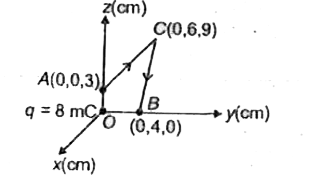" The work done in taking a charge of "+4" coulombs from A to "B" is "200" joules.If the potential of "B" is "10" volts,the potential of A in volts "
Step by step video & image solution for " The work done in taking a charge of "+4" coulombs from A to "B" is "200" joules.If the potential of "B" is "10" volts,the potential of A in volts " by Physics experts to help you in doubts & scoring excellent marks in Class 12 exams.
Similar Questions
Knowledge Check
- Question 1 - Select One
How much work is done in moving a charge of 2 coulombs from a point at 118 volts to a point at 128 volts?
A10 JB15 JC20 JD25 J - Question 2 - Select One
The work done (in Joule) in carrying a charge of x coulomb between two points having a potential difference of y volt is
AxyBx2yCyxDxy - Question 3 - Select One
Calculate the work done in taking a charge −2×10−9C from A to B via C (in diagram )
 A0.2 jouleB1.2 jouleC2.2 jouleDzero
A0.2 jouleB1.2 jouleC2.2 jouleDzero
If 10 J of work is to be done in moving a charge of -200C from A to B, which of the two points is at higher potential ? What is the potential difference ?
View SolutionThe work done in moving a charge of 20 C from A to B over a distance of 0.2 m is 2 J. The potential difference across A and B is _______.
View SolutionA work of 100 joule is performed in carrying a charge of -5 coulomb from infinity to a particular point in an electrostatic field. The potential of this point is _______.
View SolutionWork done in moving a charge q coulomb on the surface of given charged conductor of potential V is
View SolutionThe work done in carrying a charge of 5μC form a point A to a point B in an electric field is 10mJ. The potential difference (VB−VA) is then
View Solution
